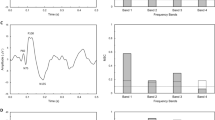Abstract
The flash visual evoked potential P2 (FVEP-P2) has been identified as a potentially useful clinical, diagnostic tool for Alzheimer’s dementia (AD) and mild cognitive impairment (MCIa) due to its association with cholinergic functioning in the brain. The FVEP-P2 is the second positive component of the VEP waveform elicited by a single strobe flash. Despite finding a selective delay in the latency of the FVEP-P2 in AD and MCIa groups, adequate levels of sensitivity and specificity have not been achieved due to natural group differences and inter-individual variability. In response, Fix and colleagues introduced a novel, double-stimulation paradigm that contained two strobe flashes (i.e., stimulations). The first stimulation served as a visual challenge while the second stimulation produced the recorded FVEP-P2 component. The results of that investigation indicated that the latency of the FVEP-P2 could be used to reliably discriminate between aMCI and healthy controls when the ISI of the double-stimulation condition was 100 ms or higher. Unfortunately, very little is known regarding the psychometric properties of the FVEP-P2 when produced by a double-stimulation condition. Consequently, we assessed the test–retest reliability of the FVEP-P2 latency produced by a single- and twelve double-stimulation conditions in a sample of young, healthy individuals (N = 20). Results indicated that while the FVEP-P2 latencies produced by the single- and double-stimulation paradigm were reliable, the intra-individual variability continued to be too high for the FVEP-P2 latency to be used clinically. Methods of reducing the intra-individual variability are discussed, including the use of monochromatic light.

Similar content being viewed by others
References
Alzheimer’s Association. (2017). 2017 Alzheimer’s disease: Facts and figures. Alzheimer’s & Dementia, 13(4), 325–373. https://www.alz.org/documents_custom/2017-facts-and-figures.pdf. Accessed 16 Dec 2017.
Andreassi, J. L., Mayzner, M. S., Davidovics, S., & Beyda, D. R. (1971). Visual evoked potentials at, above and below two-flash thresholds. Psychonomic Science, 22(3), 185–187.
Buchsbaum, M. (1970). Average evoked response: Technique and applications. Schizophrenia Bulletin, 1(3), 10–18.
Cantello, R., Strigaro, G., Prandi, P., Varrasi, C., Mula, M., & Monaco, F. (2011). Paired-pulse flash-visual evoked potentials: New methods revive and old test. Clinical Neurophysiology, 122, 1622–1628. https://doi.org/10.1016/j.cllinph.2011.01.008.
Case, J. L., Arruda, J. E., & VanWormer, L. A. (2016). Modeling cyclic variations in sustained human performance as measured by reaction time and the flash visual evoked potential-P2. International Journal of Psychophysiology, 101, 43–49. https://doi.org/10.1016/j.ijpsycho.2016.01.006.
Ciuffini, R., Marrelli, A., Necozione, T., Marini, C., Cavicchio, A., Amicosante, G., & Aloisi, P. (2014). Visual evoked potentials in Alzheimer’s disease: Electrophysiological study of the visual pathways and neurophysiological correlates. Journal of Alzheimer’s Disease and Parkinsonism, 4(5), 1–4. https://doi.org/10.4172/2161-0460.1000158.
Coburn, K. L., Amoss, R. T., Arruda, J. E., Kizer, L. D., & Marshall, Y. S. (2005). Effects of flash mode and intensity on P2 component latency and amplitude. International Journal of Psychophysiology, 55, 323–331.
Coburn, K. L., Arruda, J. E., Estes, K. M., & Amoss, R. T. (2003). Diagnostic utility of visual evoked potential changes in Alzheimer’s disease. The Journal of Neuropsychology and Clinical Neurosciences, 15(2), 175–179.
Contestabile, M. T., Suppressa, F., Tonelli, G., Giorgi, D., Antonnicola, G., & D’Alba, E. (1995). The influence of age on the flash visual evoked potentials. Acta Ophthalmologica Scandinavica, 73, 308–312.
Fix, S. T., Arruda, J. E., Andrasik, F., Beach, J., & Groom, K. (2014). Using visual evoked potentials for the early detection of amnestic mild cognitive impairment: A pilot investigation. International Journal of Geriatric Psychiatry. https://doi.org/10.1002/gps.4117.
Fletcher, L. C., Burke, K. E., Caine, P. L., Rinne, N. L., Braniff, C. A., Davis, H. R., … Packer, C. (2013). Diagnosing Alzheimer’s disease: Are we any nearer to useful biomarker-based, non-invasive tests. GMS Health Technology Assessment, 9, 1–7. https://doi.org/10.3205/hta000107.
Laske, C., Sohrabi, H. R., Frost, S. M., López-de-Ipiña, K., Garrard, P., Buscema, M., … Bridenbaugh, S. A. (2015). Innovative diagnostic tools for early detection of Alzheimer's disease. Alzheimer's & Dementia: The Journal of the Alzheimer's Association, 11(5), 561–578.
Moore, N. (1997). Visual evoked responses in Alzheimer’s disease: A review. Clinical Electroencephalography, 28(3), 137–142. https://doi.org/10.1177/155005949702800304.
Musselwhite, M., & Jeffreys, D. (1983). Visual evoked potentials to double-pulse pattern presentation. Vision Research, 23(2), 135–143. https://doi.org/10.1016/0042-6989(83)90136-0.
Odom, J. V., Bach, M., Brigell, M., Holder, G. E., McCulloch, D. L., Mizota, A., … International Society for Clinical Electrophysiology of Vision (2016). ISCEV standard for clinical visual evoked potentials: (2016 update). Documenta Ophthalmologica, 133(1), 1–9.
Petersen, R. (2004). Mild cognitive impairment as a diagnostic entity. Journal of Internal Medicine, 256(3), 183–194.
Sannita, W. G. (2006). Individual variability, end-point effects and possible biases in electrophysiological research. Clinical Neurophysiology, 117(12), 2569–2583.
Schwartz, M., & Shagass, C. (1964). Recovery functions of somatosensory and visual evoked potentials. Annals of the New York Academy of Sciences, 112(1), 510–525.
Semlitsch, H. V., Anderer, P., Schuster, P., & Presslich, O. (1986). A solution for reliable and valid reduction of ocular artifacts, applied to the P300 ERP. Psychophysiology, 23(6), 695–703.
Skrandies, W., & Raile, A. (1989). Cortical and retinal refractory periods in the human visual system. Internal Journal of Neuroscience, 44(1–2), 185–195.
Subramanian, S. K., Gaur, G. S., & Narayan, S. K. (2012). Effect of color of flash stimulus on variability of flash visual evoked potential latencies. Indian Journal of Physiology and Pharmacology, 56(4), 323–329.
Subramanian, S. K., Gaur, G. S., & Narayan, S. K. (2013). Low luminance/eye closed and monochromatic stimulation reduce variability of flash visual evoked potential latency. Annals of Indian Academy of Neurology, 16(4), 614–618.
Tartaglione, A., Spadavecchia, L., Maculotti, M., & Bandini, F. (2012). Resting state in Alzheimer’s disease: A concurrent analysis of flash-visual evoked potentials and quantitative EEG. BMC Neurology, 12(1), 1–9. https://doi.org/10.1186/1471-2377-12-145.
Author information
Authors and Affiliations
Corresponding author
Ethics declarations
Conflict of interest
The authors declare that they have no conflict of interest.
Rights and permissions
About this article
Cite this article
Wyatt-McElvain, K.E., Arruda, J.E. & Rainey, V.R. Reliability of the Flash Visual Evoked Potential P2: Double-Stimulation Study. Appl Psychophysiol Biofeedback 43, 153–159 (2018). https://doi.org/10.1007/s10484-018-9392-6
Published:
Issue Date:
DOI: https://doi.org/10.1007/s10484-018-9392-6




